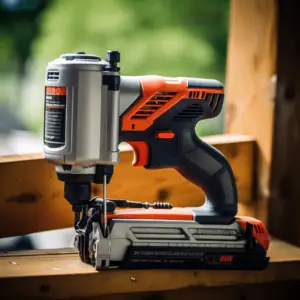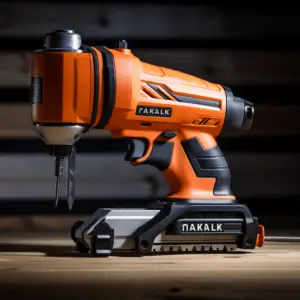Roofing vs. Siding Nailers: these two conventional tools look similar and perform just about the same task of driving nails into the wood. While each option has its attributes, you shouldn’t just use them interchangeably.
However, picture this; you are installing a siding in your project, and you realized that you have a roofing nailer and not a siding nailer. And you’re not in a position to get a roofing nailer. What would you do? Well, that’s when you start to wonder if you can use a roofing nailer for siding.
Table of Contents
Can You Use a Roofing Nailer for Siding?

Fortunately, yes. Sometimes for small projects that involve siding, buying a siding nailer may not really be necessary. You can do it just fine with a roofing nailer.
However, you have to be a little kin. Siding nails are not the same as roofing nails. Each nailer is prescribed for the job they fit. That means roofing nailers are for installing roofing and siding nailers are meant for installing siding. Check out the detailed review provided below.
Roofing Nailer Overview
At first glance, it can be tricky to differentiate between a roofing nailer and a siding nailer. While roofing nailers are usually cheaper, a lot of people would prefer buying one for use in place of a siding nailer. But these are meant for completely different fasteners, so the end results may not be as satisfying as you might think.
Roofing nailers are mainly used to put fiber glasses or asphalt shingles on the house’s rooftop. It plays a significant role in saving the houses and protecting the people inside. On the other hand, the sole purpose of siding nails is for fastening siding nails. Here are the various reasons why siding nailers may not be ideal for roofing.
Roofing nails need to come out
Contrary to siding shanks, roofing nails need to come out. Also, roof shingles are meant to be replaced occasionally, meaning the nails ought to have larger heads that are accessible and easier to grab.
Also, the fact that roofing nailers need to punch through asphalt shingles, makes it even more difficult to siding nailers which are only meant to penetrate through the siding.
Shorter Nails and Cheaper Price Tag
You don’t need to have long nails to install shingles. This is because they’re thin. Roofing nails are basically not longer than 1 1/3 inches, which is the most noticeable difference that sets a siding nailer apart from a roofing nailer. Siding nailers are meant for much longer nails that mostly start where roofing nails end.
Because they’re built for smaller nails, roofing nailers are also associated with cheaper price tags. Perhaps this is the most appealing aspect of a roofing nailer and why some folks would prefer to buy a roofing nailer, assuming that it will serve their needs.
Siding Nailer Overview
Generally speaking, a siding nailer is a coiler nailer built for installing siding into exterior walls. They seem so comparable to roofing nailers, in terms of design, and they even operate in just about the same basic configuration. Again, the major difference between these two types of power tools is in the nail they use.
Siding Nails Don’t Come Out
Unlike roofing nails, nails designed for holding up siding are expected to stay in place. In fact, siding doesn’t necessitate replacement as often as roofing. Therefore, the nails are ring-shanked to deliver the much-needed hold. They also come with smaller heads for the same reason.
Siding Nailers Don’t Fire Flush
Normally when you install a nail, you’ll have to install it flush with the surface. However, we can’t say the same for siding nails. Note that siding is susceptible to the whims of nature. That means it’s likely to undergo a lot of expansion and contraction.
As such, siding nails aren’t installed flush. Instead, you will have to leave a small gap between the siding and the head of the nail to allow for said contraction and expansion. Else, your siding would crack.
Adjustable Depth
The fact that siding is installed on a vertical surface means that it will require a lot more force to hold up compared to what’s needed on roofing that’s basically laying on a horizontal surface.
Because of these siding nails are made much longer than roofing nails; usually as long as 2 ½ inches. To make up for this, siding nailers come with adjustable depth controls so that users can decide how far the nail will be driven.
Longer Nails, Heavier Price Tags
Siding nailers are generally priced higher than roofing nailers. This drives many to opt for roofing nails as a cheaper alternative. Nonetheless, if you’re planning to drive long nails, a siding nailer can do a better job.
The Difference between Siding and Roofing Nailers

The main difference between these two almost similar tools is the size of the nails. Roofing nails and siding nails are meant to perform different jobs. As such, they are built differently.
| Roofing Nails | Siding Nails |
| Intended to be removed | Intended to be permanent |
| Smooth shank | Ring shank |
| Larger head | Smaller head |
| No longer than 1.75 inches | Up to 2.5 inches long |
You can’t always drive siding nails from a roofing nailer or vice versa. Thus, it’s best to check that you have the right fastener as well as the right nailer for the task.
Note that roofing nails basically have a smooth shank and a wider head while the siding nails feature a small head. Siding nailers are utilized for siding jobs such as woodworking, whereas roofing nailers are mostly meant for roofing jobs such as nailing shingles or fiberglass.
Finally, Roofing nails are much shorter than siding nails, mainly because they don’t have to hold up much weight. They also only have to punch through a thin shingle and a single layer of wood as opposed to siding nails where you have to leave a gap between the nail head and the siding.


